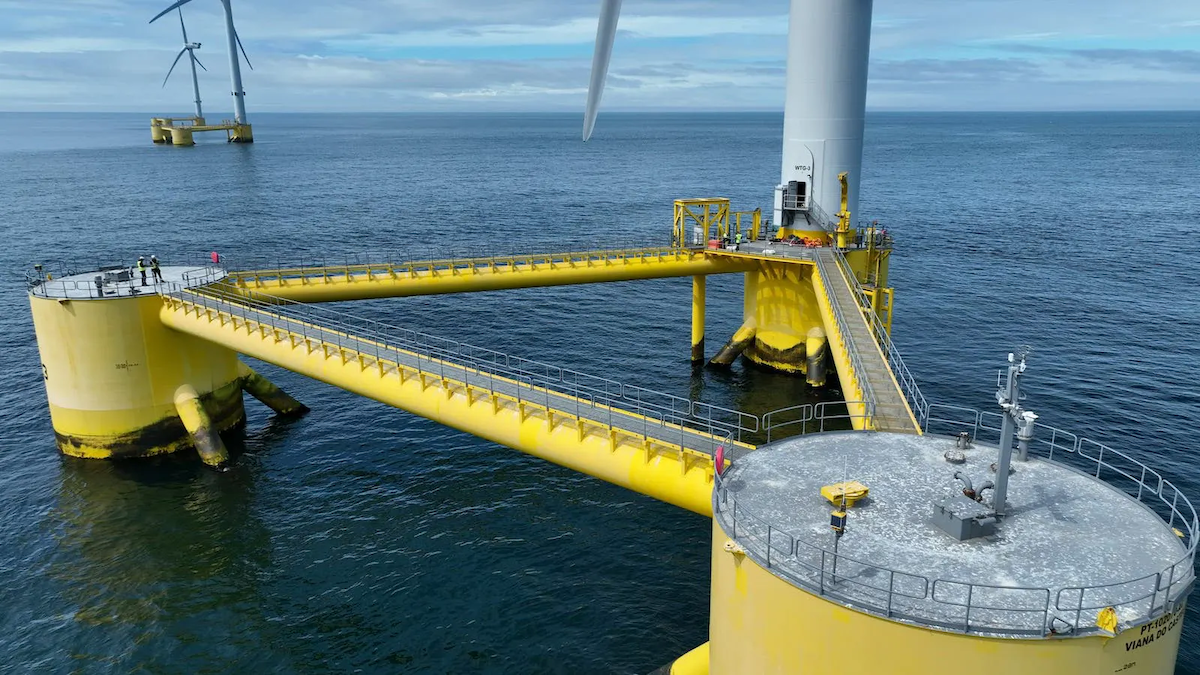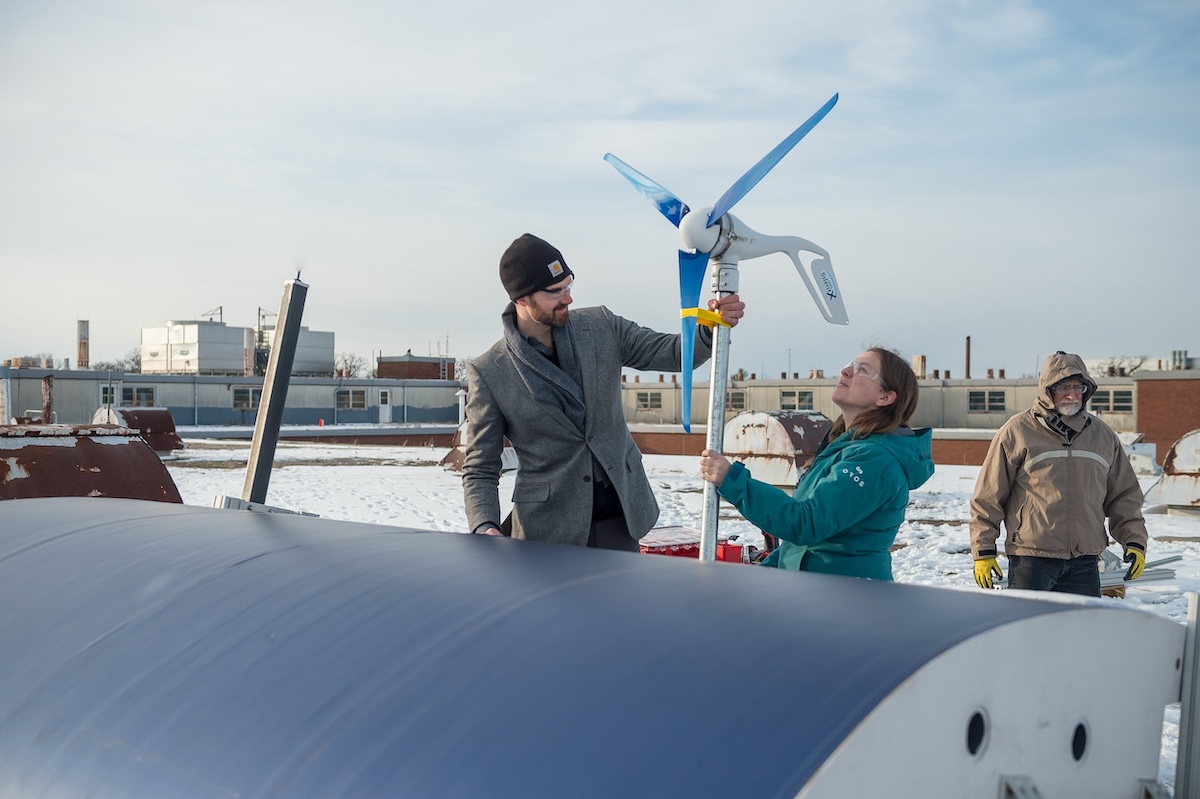
(Image credit: Imagevixen/Adobe Stock)
Wind power accounts for about 10 percent of the electricity in the U.S., representing a remarkable growth spurt in recent years. Still, with the climate crisis looming overhead, the wind energy industry needs to grow even further, and faster, than ever before. Competition for land can pose hurdles, but wind industry innovators are coming up with solutions that open up new pathways for rapid growth.
TriplePundit last rounded up five wind energy trends to watch back in 2020. Much has happened over the past four years, and here are the trends we’re watching now.
1. Repowering old wind farms
Wind turbines typically have a lifespan of about 20 years. Assuming the land remains permitted for wind energy, the turbines can be replaced with new, more powerful models as they age out.
These existing sites are already procured, zoned and prepared for wind development. That includes transmission infrastructure and road access, helping to speed up the timeline for a repowering project.
The repowering industry is already scaling up. GE Renewable Energy's RePower program, for example, has upgraded 2,500 wind turbines over 40 different wind farms in the U.S., since launching in 2017. “On average, wind turbines repowered by GE have seen a 20 percent increase in annual energy production,” according to the company.
Some repowering projects are designed to reduce the number of turbines on the site. In Illinois, for example, the firm Leeward Renewable Energy is completing an upgrade of its 80-megawatt GSG Wind farm. The wind farm’s 40 turbines and their towers will be replaced with just 26 new, more powerful models. In addition to producing more energy from the same site, Leeward expects to reduce operational costs, too.
Other repowering projects keep the supportive tower structures and only replace the turbines and the blades, potentially helping to shorten the construction timeline.
The Clean Energy branch of AES is anticipating a 20 percent increase in output from the 100.5-megawatt Clinton wind park in upstate New York after it completes the replacement of old 1.5-megawatt turbines with more powerful 1.62-megawatt models. New, longer turbine blades will contribute to the improved output.
Replacing the blades alone can also make a big difference. AES is expecting a 20 percent increase in output from its Ellenburg site in New York after it refurbishes the existing 54 turbines and installs new, longer blades.

2. Floating offshore wind turbines
Offshore wind presents another opportunity to accelerate the wind energy industry. That’s easier said than done in the U.S, where offshore wind energy projects have already encountered opposition. In addition, two-thirds of the U.S. coastline is too deep for conventional offshore wind turbines.
New floating turbines can help resolve both obstacles. Instead of sitting on monopiles fixed into the seabed, floating turbines rest on platforms tethered to the ocean floor with slim cables. They can be placed farther offshore than conventional turbines, alleviating the aesthetic concerns raised by coastal communities.
One early leader in the floating wind field is the U.S. startup Principle Power. The company has been scaling up commercial production with plans to deliver 300 floating wind turbines by 2030.
Under Joe Biden and Kamala Harris, the U.S. federal government has also set a goal of 15 gigawatts in floating offshore wind by 2035. In December, the nation took a big step toward that goal when five floating wind companies won federal leases along the California coast, totaling a potential capacity of more than 4.6 gigawatts.

3. Vertical axis wind turbines at sea
Vertical axis wind turbines represent another way to open up new opportunities for wind energy in the U.S. In contrast to the familiar long, tall, three-blade configuration of horizontal axis turbines, vertical axis turbines have a more compact, complicated shape.
Vertical axis turbines were once thought to be best suited for urban areas where space is at a premium. As it turns out, the compact footprint of vertical axis wind turbines also makes them a good fit for floating wind farms. Because they are inherently stable, they reduce, or practically eliminate, the bulky, expensive platforms needed for conventional floating turbines.
The Swedish company SeaTwirl, for example, has developed a turbine in which three vertical blades circle around a central axis. The turbine sits on a single, vertical floater that is stabilized by a satellite of small buoys.
The Norwegian company World Wide Wind has also come up with a platform-free design. Instead of buoys, the turbine is self-stabilized by two sets of vertical axis blades that rotate in opposite directions.
Here in the U.S., the Energy Department is funding floating turbine innovations that cut costs. Sandia National Laboratories for example, has introduced a new, teardrop-shaped turbine with a vertical axis. It replaces the turbine tower with tension cables, in addition to eliminating the platform.

4. New territory for small wind energy turbines
Small-sized wind turbines represent another untapped resource. Today, they are mainly used in rural and suburban areas, where land is available for the turbine towers at homes as well as farms and businesses.
For urban areas, one solution would be to place the turbine on a rooftop instead of a tower. In the past, that posed a number of technology hurdles, as well as competition for roof space from the solar industry.
Those obstacles are beginning to fall. Among the new solutions to emerge are hybrid designs that pair wind turbines with solar installations. Last September, the World Economic Forum took note of a hybrid vertical axis wind and solar rooftop system developed by a French startup called Unéole. Instead of competing for space on the existing roof, the turbines are placed under a new solar roof for even more renewable power generation.
A U.S. startup called Accelerate Wind has developed another type of solution. Its small horizontal-axis turbine is designed to sit on the edge of a roof, leaving plenty of space for other uses in the middle.
Yet another approach involves compact, standalone hybrid systems comprised of both solar panels and wind turbines. One example is a leaf-like turbine designed by the U.S. firm New World Wind. It can be arranged in tree-like clusters, with or without solar panels, to double as a form of urban sculpture.
5. Harvesting slower wind speeds
Regardless of their size or shape, wind turbines are rare in areas of U.S. where wind energy is uneconomical due to low wind speeds. That includes the Southeast, the Gulf Coast and parts of the East Coast.
New technology can boost the economic case for low-speed wind turbines in these areas. The question is whether or not they will be commercially available any time soon.
But, according to the National Renewable Energy Laboratory, this technology is on the horizon. In September, the lab reviewed up-and-coming innovations likely to reach the market before 2030. With these in hand, NREL estimates that the contiguous U.S. could economically tap into 80 percent more wind potential than it does now.
Among the elements identified by NREL are new turbines specially designed for low-speed winds. New cost-cutting manufacturing systems also play a role, including spiral welding and 3D printing. NREL also took note of new “climbing” cranes that reduce the cost of taller wind turbine towers, along with new strategies for reducing the cost of transporting longer turbine blades.
Another new technology to emerge involves control systems that tilt or turn individual turbines in a wind farm to avoid blocking the wind from one turbine to another, NREL observed.
Technology is only part of the solution to grow the wind energy sector
Against this backdrop of activity, opposition to wind development continues. A new study published in September notes that opposition can be especially intense when large wind farms are involved. Race and wealth are also factors in the opposition to large wind projects.
“This suggests an environmental justice challenge we term ‘energy privilege, wherein the delay and cancellation of clean energy in wealthier, Whiter communities leads to continued pollution in poorer communities, and communities of color,” the researchers from the University of California and University of Michigan explained.
The nature of the opposition indicates that a more vigorous effort to remedy environmental equity and justice issues could help accelerate wind development in the U.S., but that is a job for policymakers to tackle.

Tina writes frequently for TriplePundit and other websites, with a focus on military, government and corporate sustainability, clean tech research and emerging energy technologies. She is a former Deputy Director of Public Affairs of the New York City Department of Environmental Protection, and author of books and articles on recycling and other conservation themes.














